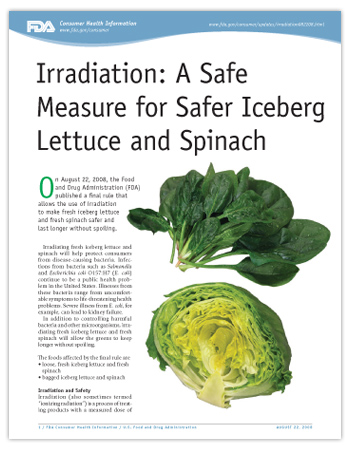For Consumers
Irradiation: A Safe Measure for Safer Iceberg Lettuce and Spinach
 |
 Get Consumer Updates by E-mail
Get Consumer Updates by E-mail
On August 22, 2008, the Food and Drug Administration (FDA) published a final rule that allows the use of irradiation to make fresh iceberg lettuce and fresh spinach safer and last longer without spoiling.
Irradiating fresh iceberg lettuce and spinach will help protect consumers from disease-causing bacteria. Infections from bacteria such as Salmonella and Escherichia coli O157:H7 (E. coli) continue to be a public health problem in the United States. Illnesses from these bacteria range from uncomfortable symptoms to life-threatening health problems. Severe illness from E. coli, for example, can lead to kidney failure.
In addition to controlling harmful bacteria and other microorganisms, irradiating fresh iceberg lettuce and fresh spinach will allow the greens to keep longer without spoiling.
The foods affected by the final rule are
- loose, fresh iceberg lettuce and fresh spinach
- bagged iceberg lettuce and spinach
Irradiation and Safety
Irradiation (also sometimes termed "ionizing radiation") is a process of treating products with a measured dose of radiation. Food irradiation is not new. FDA has conducted irradiation safety evaluations for more than 40 years and has determined the process to be safe for use on a variety of foods.
After studying the safety of irradiating fresh iceberg lettuce and fresh spinach, FDA has determined that these greens, when irradiated under the conditions specified in the final rule, retain their nutrient value and are safe to eat.
FDA considers irradiation a complement to, not a replacement for, proper food-handling practices by producers, processors, and consumers. Irradiation is an additional tool that may be used to reduce the levels of disease-causing microorganisms on fresh iceberg lettuce and fresh spinach.
Irradiation does not take the place of washing. FDA continues to recommend that consumers wash fresh and bagged produce before eating unless the packaging specifically states that the product has been prewashed.
Irradiation of Other Foods
Many foods are already permitted to be irradiated to control bacteria and keep the foods longer without spoiling. For example, FDA approved the irradiation of red meat in 1997 after reviewing numerous scientific studies conducted worldwide on the effects of irradiation on various meat products. Other examples of foods that may be irradiated to kill microbes include spices, poultry, and molluscan shellfish (such as oysters, clams, mussels, and scallops).
FDA has previously allowed lettuce, spinach, and some other foods to be irradiated to kill insects or to slow spoilage. However, the doses used for these purposes are lower than what is required to kill most disease-causing bacteria.
How Will I Know if My Fresh Iceberg Lettuce or Spinach Has Been Irradiated?
Irradiation of iceberg lettuce and spinach is voluntary on the part of food processors. FDA requires that foods that have been irradiated bear the "radura" logo along with the statement "Treated with radiation" or "Treated by irradiation."
FDA’s Role in Safe Irradiation of Food
FDA regulates sources of irradiation (the equipment used) for foods as "food additives" that require approval before being allowed on the market. FDA approves a source of irradiation for use on food only after it has determined that irradiating the food is safe at a maximum dose specified by FDA. The agency continues to evaluate the safe use of irradiation in additional foods.
This article appears on FDA's Consumer Update page, which features the latest on all FDA-regulated products.
Date Posted: August 22, 2008








